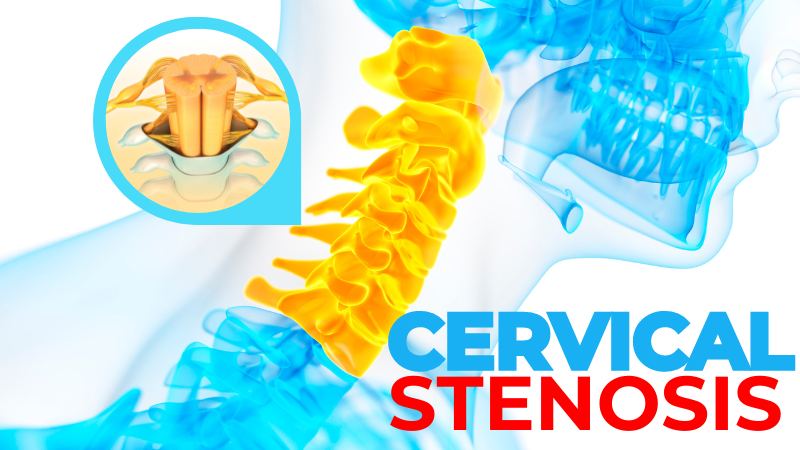Cervical stenosis is a condition characterized by a change in the bones of the neck. This, in turn, can lead to neck pain and other symptoms. While it can be a serious condition, especially if left untreated, some exercises can help halt its progression and alleviate the symptoms. In this blog, we will delve into what cervical stenosis is, what causes it, and what exercises can be done to manage the condition effectively.
What is Cervical Stenosis?
Picture this: your spinal cord is like a bustling highway, transmitting signals to and from your brain. Now, imagine a narrowing in this highway—the cervical stenosis. When this narrowing happens, it’s like a traffic jam, disrupting the smooth flow of messages to and from your hands, shoulders, and skin.
What Leads to Cervical Stenosis?
One of the main troublemakers is the wear and tear that comes with age. As the years go by, our necks may develop bone spurs, changes in boney shape, disc bulges, and thickening of ligaments which can narrow the path of the spinal cord. Picture these bone spurs as overgrown branches, encroaching on the highway and the traffic has to slow down around them. Additionally, accidents or injuries can also cause this narrowing—like a sudden roadblock causing chaos in our nerve pathways. Signs and Signals:
Recognizing Symptoms
The signs of cervical stenosis can vary. Some may feel a tingling sensation in their hands as if tiny sparks are dancing under their skin. Others might experience radiating pain, from the neck down to the shoulders or just neck pain.
Exercises for Cervical Stenosis
- Hip Mobility: The Foundation
Before focusing on neck exercises, it is important to ensure that your hips are mobile. The neck is the last point of movement before the eyes, which should always be parallel to the horizon. If there are any issues with the body below the neck, the neck compensates to keep the eyes level. To avoid this compensation, perform exercises that improve hip mobility. Start by getting into a half-kneeling position and move forward and backward to stretch the front of your hip. Make sure to maintain a strong relationship between the pubic bone and the ribs, engaging your core slightly. Additionally, perform lateral movements by moving the hips left and right. Finally, incorporate rotational movements by imagining your pelvis as a wheel and pushing it in different directions.
2. Freeing Your Upper Back: Your Neck’s Support System
The thorax, or upper back, plays a significant role in neck movement. To improve mobility in this area, perform exercises that target flexion, extension, side bending, and rotation. To target the upper back, raise your right hand above your head and reach through with your left hand, combining side bending and rotation. Repeat this movement with flexion and extension as well. Perform the same set of exercises on the opposite side. These movements will help loosen up the upper back and relieve tension in the neck.
3. Neck Mobility: The Dance of Flexibility
While it may seem counterintuitive, some exercises can improve neck mobility without moving the eyes. These exercises target rotation and side bending. To improve rotation, rotate your shoulders while keeping your head still (look at something in front of you). This movement stretches the neck muscles without causing additional pain. To target side bending, drop one arm to point to the ground as you raise the other towards the ceiling, creating a stretch in the side of your neck. Perform this exercise on both sides, ensuring that your eyes remain parallel to the horizon throughout.
4. Stretching: Unleashing the Tension
In addition to mobility exercises, it is important to directly stretch the neck muscles. One effective stretch targets the trapezius and scalene muscles. Sit on one hand to restrict movement in the shoulder. Place the other hand on top of your head and lean away from the hand you are sitting on, feeling the stretch in the side of your neck. You can adjust the angle of the stretch by leaning slightly forward or to the side. This stretch can be performed on both sides, targeting different muscles in the neck.
5. Strengthening: Building Your Neck’s Resilience
To strengthen the neck muscles, isometric exercises can be beneficial. Isometric exercises involve tensing a muscle without moving it. By pushing against your hand in different directions, you can contract and strengthen the neck muscles without causing excessive movement. Perform these isometric exercises on each side for 10-15 seconds, targeting side bending, extension, and flexion. These exercises will help build strength in the neck, providing additional support for individuals with cervical stenosis.
Conclusion
Cervical stenosis can be a debilitating condition, but with early intervention and the right exercises, its progression can be halted, and symptoms can be managed effectively. By focusing on mobility exercises for the hips and upper back, as well as targeted exercises for the neck, individuals can alleviate pain and improve their overall quality of life. Remember to consult a healthcare professional before starting any exercise regimen, especially if you have a pre-existing condition.


